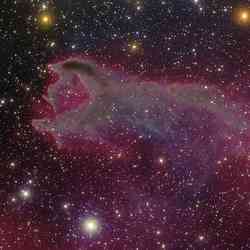
Cometary globule CG4. Image credit: NOAO. Click to enlarge
This object looks like a comet, but it’s actually a star forming region called CG4. Cometary globules like this are relatively small clouds of gas and dust in the Milky Way. CG4 is about 1,300 light years from Earth; its head is about 1.5 light-years across, and its tail is about 8 light-years long. The head of the nebula is opaque, but it’s illuminated by the light from the hot newly forming stars.
A dramatic new image of cometary globule CG4 marks the one-thousandth image posted to the online gallery hosted by the National Optical Astronomy Observatory.
The flower-like image of this star-forming region in Earth’s southern skies was taken by Travis Rector and Tim Abbott using a 64-megapixel Mosaic imaging camera on the National Science Foundation’s Victor M. Blanco telescope at Cerro Tololo Inter-American Observatory.
Cometary globules are isolated, relatively small clouds of gas and dust within the Milky Way. This example, called CG4, is about 1,300 light years from Earth. Its head is some 1.5 light-years in diameter, and its tail is about 8 light-years long. The dusty cloud contains enough material to make several Sun-sized stars. CG4 is located in the constellation of Puppis.
The head of the nebula is opaque, but glows because it is illuminated by light from nearby hot stars. Their energy is gradually destroying the dusty head of the globule, sweeping away the tiny particles which scatter the starlight. This particular globule shows a faint red glow from electrically charged hydrogen, and it seems about to devour an edge-on spiral galaxy (ESO 257-19) in the upper left. In reality, this galaxy is more than a hundred million light-years further away, far beyond CG4.
The image from the 4-meter telescope was taken in four filters, three of which are for blue, green and near-infrared light. The fourth is designed to isolate a specific color of red, known as hydrogen-alpha, which is produced by warm hydrogen gas.
The National Optical Astronomy Observatory (NOAO) consists of Kitt Peak National Observatory near Tucson, AZ; Cerro Tololo Inter-American Observatory near La Serena, Chile; and, the NOAO Gemini Science Center, the route for U.S. astronomers to observe with the Gemini North telescope in Hawaii and the Gemini South telescope in Chile. NOAO is operated by the Association of Universities for Research in Astronomy Inc. (AURA), under a cooperative agreement with the National Science Foundation.
Original Source: NOAO News Release
